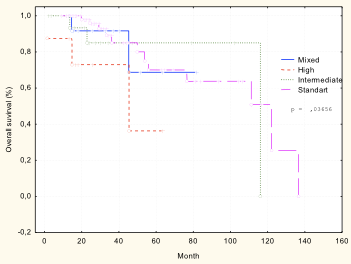
Contributions
Type: Publication Only
Background
Cytogenetic analyses, including fluorescence in situ hybridization (FISH) is integral part of stratification in patients with multiple myeloma on risk groups. Detection of specific abnormalities optimizes treatment strategy for life expectancy improvement. The impact of the mixed specific genetic aberrations on the overall survival (OS) is studied.
Aims
To estimate the OS in patients with multiple myeloma, according to risk stratification.
Methods
133 patients were prospectively assessed (median age 61 years, range 26 - 93; male: female ratio – 1:1.27) with newly diagnosed multiple myeloma. Cytogenetic and FISH analyses were determined in all patients for search of genetic abnormalities. Cytogenetic studies were performed on bone marrow samples using standard GTG-method. Metaphase FISH analyses were performed according to the manufacturer's protocol with use of DNA probes: LSI 13(RB1)13q14, IGH/CCND1, IGH/FGFR3, LSI TP53 (17q13.1) (Abbott). Stratification of patients was carried in risk groups according to the molecular classification mSMART 2.0 Patients with nonspecific genetic abnormalities were included in standard risk group. Patients with complex karyotype (3 and more chromosomal aberrations) and who has 2 specific chromosomal abnormalities were included in certain group - mixed specific genetic aberrations risk group.
Results
Genetic abnormalities in newly diagnosed multiple myeloma were detected in 49.5% (56/113). The occurrence frequency of t(11;14) was 26.5% (n=30), del(13q) – 22.1% (n=25), t(4;14) – 7.1% (n=8), del(17p) – 7.1% (n=8). 73/113 (64.4%) patients was in standard risk group, 17/113 (15,0%) – intermediate risk, 8/113 (7,1%) – high risk and 15/113 (13,3%) – with mixed specific genetic aberrations risk. 5-years OS in standard risk group was 70%, in intermediate risk - 84% (p=.42), in high risk – 36.5% and in group with mixed specific genetic aberrations – 68.7% (p=.036).
Summary
Genetic abnormalities are important prognostic factors in patients with multiple myeloma. Identification of specific genetic markers, which included into high risk group, is a reason for search of optimal strategy of therapies. The obtained data need in further analysis taking into account age and variants of anti-myeloma therapies.
Keyword(s): Cytogenetic abnormalities, Fluorescence in situ hybridization, Myeloma, Survival

Type: Publication Only
Background
Cytogenetic analyses, including fluorescence in situ hybridization (FISH) is integral part of stratification in patients with multiple myeloma on risk groups. Detection of specific abnormalities optimizes treatment strategy for life expectancy improvement. The impact of the mixed specific genetic aberrations on the overall survival (OS) is studied.
Aims
To estimate the OS in patients with multiple myeloma, according to risk stratification.
Methods
133 patients were prospectively assessed (median age 61 years, range 26 - 93; male: female ratio – 1:1.27) with newly diagnosed multiple myeloma. Cytogenetic and FISH analyses were determined in all patients for search of genetic abnormalities. Cytogenetic studies were performed on bone marrow samples using standard GTG-method. Metaphase FISH analyses were performed according to the manufacturer's protocol with use of DNA probes: LSI 13(RB1)13q14, IGH/CCND1, IGH/FGFR3, LSI TP53 (17q13.1) (Abbott). Stratification of patients was carried in risk groups according to the molecular classification mSMART 2.0 Patients with nonspecific genetic abnormalities were included in standard risk group. Patients with complex karyotype (3 and more chromosomal aberrations) and who has 2 specific chromosomal abnormalities were included in certain group - mixed specific genetic aberrations risk group.
Results
Genetic abnormalities in newly diagnosed multiple myeloma were detected in 49.5% (56/113). The occurrence frequency of t(11;14) was 26.5% (n=30), del(13q) – 22.1% (n=25), t(4;14) – 7.1% (n=8), del(17p) – 7.1% (n=8). 73/113 (64.4%) patients was in standard risk group, 17/113 (15,0%) – intermediate risk, 8/113 (7,1%) – high risk and 15/113 (13,3%) – with mixed specific genetic aberrations risk. 5-years OS in standard risk group was 70%, in intermediate risk - 84% (p=.42), in high risk – 36.5% and in group with mixed specific genetic aberrations – 68.7% (p=.036).
Summary
Genetic abnormalities are important prognostic factors in patients with multiple myeloma. Identification of specific genetic markers, which included into high risk group, is a reason for search of optimal strategy of therapies. The obtained data need in further analysis taking into account age and variants of anti-myeloma therapies.
Keyword(s): Cytogenetic abnormalities, Fluorescence in situ hybridization, Myeloma, Survival



